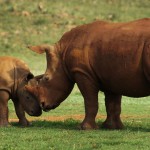By Melanie Verwoerd, courtesy of Conservation Action Trust.

When it comes to statistics, the devil is always in the detail – or in the spin, when it come to politics. The fight against rhino poaching is no exception.
On the 8th of May, the Minister for Environmental Affairs and Tourism, Minister Edna Molewa, gave her regular progress report on the fight against rhino poaching.
She announced that between 1 Jan 2016 and May 2016, the number of Rhinos killed was down by 23% and that great progress is being made in preventing rhino killings as well as prosecuting the poachers. As has become the practice at these regular briefings, great attention was paid to the success of the Hawks and other law enforcement agencies in apprehending perpetrators as well as the conviction rate by the NPA.
This time round the minister highlighted, amongst others, that between April of last year and March 2016, 49 cases involving 103 accused were finalised. Of the 103 accused 80 were found guilty, thus she claimed a 78% successful conviction rate.
It seems that the NPA is having tremendous success with rhino prosecutions, since the Minister announced earlier this year an 88% conviction rate for 2015. A phenomenal achievement … or is it?
The problem lies in the NPA’s and thus the minister’s definition of “conviction rate”. The NPA defines the conviction rate or successful prosecutions as the percentage of cases finalised with a guilty verdict divided by the number of cases finalised with a verdict.
In other words, the percentage only takes into account those cases that went to trial and where there was some form of verdict. It has no relation to the number of crimes committed (in this case the amount of rhinos killed), the number of reported crimes or even the number of arrests made.
This means that the conviction rate does not reflect a very accurate picture. Let’s for example, use the 2015 statistics as announced by the Minister in January 2016. In 2015, 1175 rhinos were killed illegally. This lead to 317 arrests. The minister announced that 48 accused persons were convicted during this time thus claiming the previously mentioned 88% conviction rate. But that means that only 54 people were prosecuted – 17% of those arrested in 2015.
If the conviction rate of the total of those arrested for rhino crimes is calculated, the percentage stands at a pitiful 15%.
Of course this issue is not unique to the Ministry and Department of Environmental Affairs. It cuts across all departments, and criminologists repeatedly point out that this manner of calculating convictions rates means that the NPA is less likely to prosecute cases that they feel that might stand a chance of not seeing a conviction. Thus even where prima facie cases exist, the NPA might decline to prosecute since it might not look so good when the stats are compiled.
It is true that some of these cases will date back to crimes committed in previous years. This, together with the fact that the minister does not tell us how many cases were in fact prosecuted and to how many rhino killings these cases relate, make it very difficult to get an accurate picture.
So why is this so important in this context?
Firstly, because it means that 83% of those arrested were not prosecuted and are thus free to repeat their activities. Of course some might not have been guilty, but those who were and got away with it will be likely to try again. Secondly, because it might create the impression that the battle against rhino poaching is being won, when in fact it is being lost.
It can not be denied that some progress is being made. But the progress is painfully slow. Even though the amount of rhinos killed this year is down by 23%, a staggering 363 rhinos have already been slaughtered in 2016. And there is clearly no slow down in the attempts made by poachers. According to the minister, there was an increase of 28% in poaching activities in the Kruger National Park in the first four months of this year. As she puts it “a staggering 1038 (activities) in the Kruger National Park alone”. This is up from 808 activities for the same period last year.
Many organisations such as TRAFFIC and WWF have also pointed out that despite the progress made by the South African government, rhino poaching hit an all time high across Africa in 2015.
As Major General Johan Jooste, who is in charge of SANParks’ anti-poaching activities, said at the press conference in January: “There is a difference between success and victory.”
We therefore need to be careful not to be lulled into complacency by statistics.
About the author: Melanie Verwoerd is a former ANC MP and SA Ambassador to Ireland. She served on the Environmental Affairs and Tourism standing committees.




